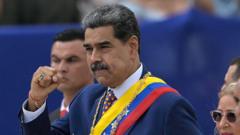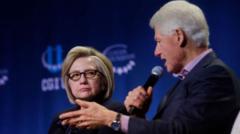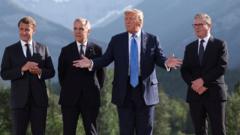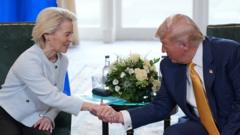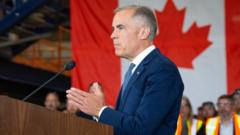The World Trade Organization highlights significant trade declines due to US tariffs, forecasting a drop in global trade particularly in North America, while indicating regions like Asia and Europe may still see growth.
**WTO Warns: US Tariffs Could Lead to Global Trade Decline**
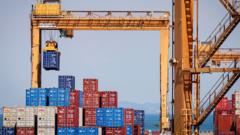
**WTO Warns: US Tariffs Could Lead to Global Trade Decline**
The WTO predicts a downturn in international trade as US tariffs affect global relations and economic growth.
The World Trade Organization (WTO) has issued a stark warning about the potential shrinkage of global trade this year, attributing the decline primarily to the tariffs imposed by the United States under President Donald Trump. At a news conference in Geneva, WTO Director-General Ngozi Okonjo-Iweala expressed concern over deteriorating US-China relations, labeling the trend of "decoupling" between the two economic giants as "really worrying."
The WTO now anticipates that global goods trade could decline by 0.2% in 2025, a significant reduction from its earlier projection of a 2.7% increase. Accompanying this grim forecast are comments from Chief Economist Ralph Ossa, who highlighted that the uncertainty surrounding trade policies leads to adverse effects on trade flows and overall economic activity.
Moreover, the UN's trade body, UNCTAD, has echoed these concerns, predicting that global economic growth will slow to 2.3% in 2025, falling below the critical threshold of 2.5% often associated with recession signals. The looming presence of reciprocal tariffs and ongoing political uncertainties contribute to a dim outlook for international trade.
The manifestation of these tariffs began on April 5 with a baseline 10% tax on nearly all foreign imports to the US, though certain products and countries have been exempted. Notably, tariffs on Chinese imports have surged to an overwhelming average of 145%. The response from the US stock market has been reactive, with declines noted as uncertainty waxes amidst the ongoing trade disputes.
Despite the anticipated downturn tied to US tariffs, the WTO has identified specific regions, particularly Asia and Europe, which could experience growth in exports and imports this year. Their report also introduces a forecast for services trade, predicting modest growth of 4% in 2025, though this is a downward revision from prior expectations.
President Trump's ongoing tariff announcements have created a turbulent environment for international trade, ostensibly intended to bolster American manufacturing and stimulate domestic investment. However, critics argue that revitalizing US manufacturing is a complex, long-term process, and the immediate impacts of these tariffs may hinder economic expansion in the interim.
As Trump navigates political pressures and market reactions, his administration has frequently adjusted tariff plans, recently pausing tariffs against many nations except China. This fluctuation reflects the dynamic and often contentious nature of the current global trade narrative, illustrating the intricate interdependence of economies in a rapidly evolving marketplace.
As tariffs and trade tensions remain at the forefront of economic policy, businesses and consumers alike are left to grapple with the consequences, while anticipating recovery in certain regions despite larger global challenges.
The WTO now anticipates that global goods trade could decline by 0.2% in 2025, a significant reduction from its earlier projection of a 2.7% increase. Accompanying this grim forecast are comments from Chief Economist Ralph Ossa, who highlighted that the uncertainty surrounding trade policies leads to adverse effects on trade flows and overall economic activity.
Moreover, the UN's trade body, UNCTAD, has echoed these concerns, predicting that global economic growth will slow to 2.3% in 2025, falling below the critical threshold of 2.5% often associated with recession signals. The looming presence of reciprocal tariffs and ongoing political uncertainties contribute to a dim outlook for international trade.
The manifestation of these tariffs began on April 5 with a baseline 10% tax on nearly all foreign imports to the US, though certain products and countries have been exempted. Notably, tariffs on Chinese imports have surged to an overwhelming average of 145%. The response from the US stock market has been reactive, with declines noted as uncertainty waxes amidst the ongoing trade disputes.
Despite the anticipated downturn tied to US tariffs, the WTO has identified specific regions, particularly Asia and Europe, which could experience growth in exports and imports this year. Their report also introduces a forecast for services trade, predicting modest growth of 4% in 2025, though this is a downward revision from prior expectations.
President Trump's ongoing tariff announcements have created a turbulent environment for international trade, ostensibly intended to bolster American manufacturing and stimulate domestic investment. However, critics argue that revitalizing US manufacturing is a complex, long-term process, and the immediate impacts of these tariffs may hinder economic expansion in the interim.
As Trump navigates political pressures and market reactions, his administration has frequently adjusted tariff plans, recently pausing tariffs against many nations except China. This fluctuation reflects the dynamic and often contentious nature of the current global trade narrative, illustrating the intricate interdependence of economies in a rapidly evolving marketplace.
As tariffs and trade tensions remain at the forefront of economic policy, businesses and consumers alike are left to grapple with the consequences, while anticipating recovery in certain regions despite larger global challenges.


